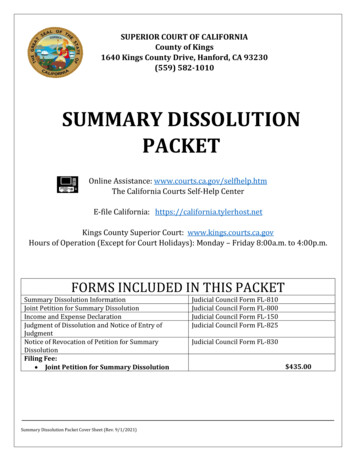
Transcription
SUPERIOR COURT OF CALIFORNIACounty of Kings1640 Kings County Drive, Hanford, CA 93230(559) 582-1010SUMMARY DISSOLUTIONPACKETOnline Assistance: www.courts.ca.gov/selfhelp.htmThe California Courts Self-Help CenterE-file California: https://california.tylerhost.netKings County Superior Court: www.kings.courts.ca.govHours of Operation (Except for Court Holidays): Monday – Friday 8:00a.m. to 4:00p.m.FORMS INCLUDED IN THIS PACKETSummary Dissolution InformationJoint Petition for Summary DissolutionIncome and Expense DeclarationJudgment of Dissolution and Notice of Entry ofJudgmentNotice of Revocation of Petition for SummaryDissolutionFiling Fee: Joint Petition for Summary DissolutionJudicial Council Form FL-810Judicial Council Form FL-800Judicial Council Form FL-150Judicial Council Form FL-825Judicial Council Form FL-830 435.00Summary Dissolution Packet Cover Sheet (Rev. 9/1/2021)
FL-810SUMMARY DISSOLUTIONINFORMATIONThis booklet is available in English and Spanish from the office of the court clerk in the superior court of each county inCalifornia, or at www.courts.ca.gov/documents/f/810.pdfand www.courts.ca.gov/documents/f/810s.pdf.Este folleto puede obtenerse en ingles yen espaiiol en la Direcci6n de Registro Publico del Condado (Office ofthe Court Clerk) o en la Corte Superior (Superior Court) de cada condado en el estado de California o en el sitiowww.courts.ca. govldocuments/f/81 O.pdf y www.courts.ca. govldocumentslf/81 Os.pdf.Fom, Adopted for Mandatory UseJudicial Council of CaliforniaFL-810 [Rev. September 1, 2021]Family Code, §§ 2400-2406www.courts.ca.gov
CONTENTSPageI.WHAT IS THIS BOOKLET ABOUT?II.SOME TERMS YOU NEED TO KNOW . . . . . . . . . . . . . . . . . . . . . . . . . . . . . . . . . . . . . . . . . . . . . . . . . . . .2Ill.WHO CAN USE THE SUMMARY DISSOLUTION PROCEDURE?.3IV. AN IMPORTANT DIFFERENCE BETWEEN SUMMARY DISSOLUTIONAND REGULAR DISSOLUTION . . . . . . . . . . . . . . . . . . . . . . . . . . . . . . . . . . . . . . . . . . . . . . . . . . . . . . . . .4V.VI.HOW DO YOU FIGURE OUT THE VALUE OF YOUR PROPERTYAND THE AMOUNT OF YOUR DEBTS? . . . . . . . . . . . . . . . . . . . . . . . . . . . . . . . . . . . . . . . . . . . . . . . . . .5SAMPLE WORKSHEET FOR DETERMINING VALUE OF SEPARATE PROPERTY . . . . . . . . . . . . . . . .6SAMPLE WORKSHEET FOR DETERMINING VALUE AND DIVISION OF COMMUNITY PROPERTY.8SAMPLE WORKSHEET FOR DETERMINING COMMUNITY OBLIGATIONS AND THEIR DIVISION . . . . 10VII. WHAT SHOULD BE INCLUDED IN THE PROPERTY SETTLEMENT AGREEMENT? . . . . .12VIII. SAMPLE PROPERTY SETTLEMENT AGREEMENT. . . . . . . . . . . . .13IX.WHAT STEPS DO YOU HAVE TO TAKE TO GET A SUMMARY DISSOLUTION? . . . . . .16X.WHAT YOU SHOULD KNOW ABOUT REVOCATION . . . . . . . . . . . . . . . . . . 18XI.SHOULD YOU SEE A LAWYER? . . . . . . . . . . . . . . . . . . . . . . . . . . . . . . . . . . . . . . . . . . . . . . . . . . . . . . . . 19XII. SOME GENERAL INFORMATION. . . . . . . . . . . . . . . . . . . . 20i.
I.WHAT IS THIS BOOKLET ABOUT?This booklet describes a way to end a marriage, a domestic partnership, or both through a kind of divorce calledsummary dissolution.The official word for divorce in California is dissolution. There are two ways of getting a divorce, or dissolution, inCalifornia. The usual way is called a regular dissolution.Summary dissolution is a shorter and easier way. But not everybody can use it. Briefly, a summary dissolution is possiblefor couples who1. have no children together;2. have been married and/or in a domestic partnership five years or less (this means that the time between the dateyou married or registered your domestic partnership and the date you separated from your spouse or domesticpartner is five years or less);3. do not own very much;4. do not owe very much;5. do not want spousal or domestic partner support from each other; and6. have no disagreements about how their belongings and their debts are going to be divided up once they are nolonger married to or in a domestic partnership with each other.With this procedure, you will not have to appear in court. You may not need a lawyer, but it is in your best interest to see alawyer about the ending of your marriage or domestic partnership. See page 19 for more details about how a lawyer canhelp you.For a summary dissolution, you prepare and file a Joint Petition for Summary Dissolution (form FL-800), together with aproperty settlement agreement,* with the superior court clerk in your county. You will also prepare and turn in a Judgmentof Dissolution and Notice of Entry of Judgment (form FL-825). Your divorce, ending your marriage and/or your domesticpartnership, will be final six months after you file your Joint Petition for Summary Dissolution. During the six months whileyou wait for your divorce to become final , either of you can stop the process of summary dissolution if you change yourmind. One of you can file a Notice of Revocation of Petition for Summary Dissolution (form FL-830), and that will stop thedivorce. If either one of you still wants to get divorced, then that person will have to file for a regular dissolution with aPetition-Marriage/Domestic Partnership(form FL-100) unless you both agree to start a new summary dissolutionprocess.IMPORTANT! Domestic partners who qualify for a summary dissolution can choose to use the process described in thisbooklet OR a special summary dissolution for domestic partners through the California Secretary of State. You can findthe California Secretary of State forms at www.sos.ca .gov. There is no filing fee for this process. If you choose to fileto terminate your domestic partnership through the Secretary of State, do not use this guide.This booklet will tell you1. who can use the summary dissolution procedure;2. what steps you must take to get a summary dissolution;3. when it would help to see a lawyer; and4 . what risks you take when you use this procedure rather than the regular dissolution procedure.If you wish to use the summary dissolution procedure, you must, at the time you file the joint petition, sign a statementthat says you have read and understood this booklet. It is important for you to read the whole booklet very carefully.Save this booklet for at least six months if you decide to start a summary dissolution . If you decide you want to stop thesummary dissolution process and revoke your petition, it will tell you how to do that.SPECIAL WARNINGIf you are an undocumented person who became a lawful permanent resident on the basis of your marriage to a U.S.citizen or to a lawful permanent resident, obtaining a dissolution within two years of your marriage may lead to yourdeportation. You should consult a lawyer before obtaining a divorce.* A property settlement agreement is an agreement that the two of you write or have someone write for you after you fill out the worksheets in thisbooklet. The agreement spells out how you will divide what you own and what you owe.-1-
11. SOME TERMS YOU NEED TO KNOWIn the following pages, you will often see the terms community property, separate property, and community obligations.Those terms are explained in this section .As a married couple or domestic partners, the two of you are, in the eyes of the law, a single unit. There are certain thingsthat you own together rather than separately. And there may be certain debts that you owe together. If one of youborrows money or buys something on credit, the other one can be made to pay.If your marriage or domestic partnership breaks up, you become two separate individuals again . Before that can happen,you have to decide what to do with the things you own as a couple and the money you owe as a couple.The laws that cover these questions contain the terms community property, separate property, and communityobligations. To understand what these terms mean, you should have a clear idea of the length of time you livedtogether as spouses or domestic partners. This is the period between the day you married or registered your domesticpartnership and the day you separated.It may not be easy to decide exactly when you separated. In most cases, the day of the separation is the day the couplestopped living together. However, you may want to choose the day when you definitely decided to get a divorce and tooksome action to show this (like telling your spouse or domestic partner that you wanted a divorce).Community PropertyCommunity property is everything spouses or registered domestic partners own together.In most cases that includes1. money you now have that either of you earned during the time you were living together as spouses or domesticpartners; and2. anything either of you bought with money earned during that period. It does not matter if only one of you earned orspent the money.Separate PropertySeparate property is everything spouses or registered domestic partners own separately from each other.In most cases that includes1. anything either of you owned before you got married or registered your domestic partnership;2. anything either of you earned or received after your separation; and3. anything either of you received, as a gift or by inheritance, at any time.Community ObligationsCommunity obligations are the debts spouses or registered domestic partners owe together.In most cases that includes anything you still owe on any debts either of you acquired during the time you were livingtogether as spouses or registered domestic partners. (For instance, if you bought furniture on credit while you weremarried or domestic partners and living together, the unpaid balance is a part of your community obligations.) It usuallydoes not matter if the debt was in the name of one spouse or domestic partner only, like on a credit card.NOTE: If you have any questions about your separation date or about your property, it would be good to see a lawyer asthese issues can be complicated. Also, if you lived together before your marriage or domestic partnership, you may wishto see a lawyer about possible additional rights either of you may have .-2-
Ill. WHO CAN USE THE SUMMARY DISSOLUTION PROCEDURE?You can use the summary dissolution procedure only if all of the following statements are true about you at the time youfile the Joint Petition for Summary Dissolution (form FL-800 ). Check this list very carefully. If even one of thesestatements is not true for you, you cannot get a divorce in this way.1. We have both read this booklet, and we both understand it.2. We have been married or registered as domestic partners five years or less between the date that we gotmarried and/or registered our domestic partnership and the date we separated. (Note that if you are trying toend both a marriage AND a domestic partnership at the same time through a summary dissolution, both yourmarriage and domestic partnership must have lasted five years or less.)3. No children were born to the two of us together before or during our marriage and/or domestic partnership.4. We have no adopted children under 18 years of age.5. Neither one of us is pregnant.6. Neither of us owns any part of any land or buildings.7. Our community property is not worth more than 47,000. (Do not count cars in this total.)8. Neither of us has separate property worth more than 47,000. (Do not count cars in this total.)9. The total of our community obligations (other than cars) is 6,000 or less.For deciding on statements 7, 8, and 9, use the guide on pages 5-11.10. a. At least one of us has lived in California for the past six months or longer and has lived in the countywhere we are filing for dissolution for the past three months or longer; orb. We are only asking to end a domestic partnership registered in California; orc. We are the same sex and were married in California but are not residents of California. Neither of uslives in a place that will allow us to divorce. We are filing this case in the county in which we married.11. We have prepared and signed an agreement that states how we want our possessions and debts to bedivided between us (or states that we have no community property or community obligations).12. We have both signed the joint petition and all other papers needed to carry out this agreement.13. Together with the joint petition , we will turn in the judgment of dissolution forms and two self-addressedstamped envelopes to the superior court.14. We both want to end the marriage and/or domestic partnership because of serious, permanent differences.15. We have both agreed to use the summary dissolution procedure rather than the regular dissolution procedure.16. We are both aware of the following facts :a. There is a six-month waiting period, and either of us can stop the divorce at any time during this period.b. The date that appears on the Judgment of Dissolution of Marriage and Notice of Entry of Judgment(form FL-825) we receive from the court as the "effective date" of the dissolution is the date our divorcewill be final, unless one of us has asked to stop the divorce prior to that effective date.c. After the dissolution becomes final, neither of us has any right to expect money or support from the otherexcept that which is included in the property settlement agreement.d. By choosing the summary dissolution procedure, we give up certain legal rights that we would have if wehad used the regular dissolution procedure. These rights are explained on page 4.-3-
IV. AN IMPORTANT DIFFERENCE BETWEEN SUMMARY DISSOLUTIONAND REGULAR DISSOLUTIONWith a regular dissolution, either spouse or domestic partner can ask for a court hearing or trial. And with a regulardissolution, if either spouse or domestic partner is unhappy with the judge's final decision, it is possible to challenge thatdecision. This can be done, for example, by asking for a new trial. It is also possible to appeal the decision by taking thecase to a higher court.With a summary dissolution, there is no trial or hearing. Couples who choose this method of getting a divorce do nothave the right to ask for a new trial (since there is no trial) or the right to appeal the case to a higher court.There are, however, some cases in which a divorce agreement under a summary dissolution can be challenged. You willhave to see a lawyer about this. The court may have the power to set aside the divorce if you can show that one of thefollowing things happened:1. You were treated unfairly in the property settlement agreement.This is possible if you find out that the things you agreed to give your spouse or domestic partner were much morevaluable than you thought at the time of the dissolution .2. You went through the dissolution procedure against your will.This is possible if you can show that your spouse or domestic partner used threats or other kinds of unfair pressure toget you to go along with the divorce.3. There are serious mistakes in the original agreement.Some kinds of mistakes can make the dissolution invalid, but you will have to go to court to prove the mistakes. It maybe that one or both of you had a lot of property that you had forgotten about when you drew up the property settlementagreement. Or maybe a bank account mentioned in the agreement had much more money or much less money in itthan your agreement states.4. Neither of you complied with preliminary disclosure requirements.California law requires that you fully share all information about your property and debts as well as your income. Youhave to share this information before you sign your property settlement agreement.In summary dissolution cases, this means that you and your spouse or domestic partner must each complete andexchange: (1) an Income and Expense Declaration (form FL-150), (2) all tax returns you filed in the last two years, and(3) the property worksheets on pages 7, 9, and 11 (or a Declaration of Disclosure(form FL-140)and either a Scheduleof Assets and Debts (form FL-142) or a Property Declaration (form FL-160)).In addition, each spouse or -domestic partner must complete and give to the other spouse or domestic partner a writtenstatement about any investment opportunity, business opportunity, or other income-producing opportunity thatdeveloped since the date you separated which was based on any investment made, significant business done, orother income-producing opportunity that was presented to you between the date you married or became domesticpartners and the date you separated .Correcting mistakes and unfairness in a summary dissolution proceeding can be expensive, time-consuming, anddifficult. It is very important for both of you to be honest, cooperative, and careful when you or your lawyers do thepaperwork for the dissolution .-4-
V. HOW DO YOU FIGURE OUT THE VALUE OF YOUR PROPERTY AND THEAMOUNT OF YOUR DEBTS?Section Ill, page 3, lists statements that must be true if you want to use the summary dissolution procedure.Statement 7 reads: "Our community property is not worth more than 47,000."Your community property is the money and things you own jointly as spouses or domestic partners. This was explainedon page 2. The value of your community property is determined by adding together (1) the amount of money you have ascommunity property and (2) the "fair market value" of the possessions you have as community property.The fair market value is an estimate of the amount of money you could get if you sold these items to a stranger-forexample, through a classified ad in the newspaper. It does not mean what you paid for it originally, and it does not meanhow much it would cost you to replace it if you lost it.One way of estimating the fair market value of your goods is to use prices for equivalent items in other people's classifiedads for secondhand goods.Three kinds of items go into figuring out your community property:1. Money (as in bank accounts and credit union accounts);2. Things you own outright (furniture that is already paid for, for example); and3. Things you are buying on credit.When you include things you still owe money on, subtract the amount of money you still owe on them from the fair marketvalue.You should not include the value of a car in this list.Statement 8 reads: "Neither of us has separate property worth more than 47,000."Separate property is property that each spouse or domestic partner owns separately. The term is explained on page 2.Separate property includes the same kinds of things used in determining community property. And again, you should notinclude cars in this list.Statement 9 reads: "The total of our community obligations (other than cars) is 6,000 or less.''Your community obligations are the debts that you and your spouse or domestic partner owe jointly. The term is explainedon page 2. List all the debts you have that you took on while you were living together as spouses or domestic partners. Ifyou borrowed money before you got married or registered your domestic partnership, you do not have to include that inyour community obligations. If you bought furniture on credit after you got married or registered your domestic partnershipbut before you separated , you have to include the amount of money you still owe on the furniture. If you bought a stereoafter you separated, you do not have to include that.Do not include car loans in this list.NOTICE: The law for summary dissolution allows you to leave out cars when you figure out whether you are eligible forthis kind of divorce. But if you do have cars as part of your community property, you still have to decide who is going toown them (and who is going to pay for them) after your divorce. You must include them in your property settlementagreement.Worksheets to help you figure out these amounts are found on pages 6-11. You may use the following forms in thisbooklet to figure out the total of your community and separate property assets and obligations: (1) the worksheet onpages 7 (Value of Separate Property), (2) the worksheet on page 9 (Value and Division of Community Property), and (3)the worksheet on page 11 (Community Obligations and Their Division). Sample forms showing how to fill out thoseworksheets are on pages 6, 8, and 10.-5-
PETITIONER 1:PatPETITIONER 2:ChrisCASE NUMBER:VI. SAMPLE WORKSHEET FOR DETERMINING VALUE OFSEPARATE PROPERTYThis worksheet will help you determine whether you are eligible to use the summary dissolution procedure. The total fairmarket value of the separate property of one spouse/domestic partner cannot be more than 47,000. The total fairmarket value of the separate property of the other spouse/domestic partner cannot be more than 47,000. Separateproperty is anything that either of you owned or earned before you got married or registered your domestic partnership,anything you earned or bought after your separation, and anything that was given to just one of you as a gift during yourmarriage or domestic partnership. Do not include cars .Note: The information on this form is for an imaginary couple, Pat and Chris, who are married. (When you fill out yourworksheet, use your information.)A.Chris'sPropertyFair MarketValuePat'sPropertyFair MarketValueBank accounts, credit union accounts, retirement funds, cashvalue of insurance policies, etc.Item 420.00Credit union savings-Pat (before marriage) 250.00Savings bonds-Chris (bought before marriage) 1,500.00Pension plan benefits-Pat (before marriage and after separation) 1 ,300.00Pension plan benefits-Chris (before marriage and after separation)B.Items owned outrightItemClothes-Pat (bought before marriage) 350.00Stocks-Pat (birthday present from father) 375 .00Furniture-Pat (owned before marriage) 460 .00Camera-Chris (owned before marriage) 229.00Wristwatch-Chris (bought after separation) 142.00Clothes-Chris (bought after separation) 250.00C.Items being bought on creditItemFair MarketValueMinusWhat's Owed TV set-Pat (after separation) 400.00 350.00 50.00Clothes-Pat (after separation) 220.00 170.00 50.00GRAND TOTALS:Pat and ChrisSEPARATE PROPERTY-6- 2 ,171 .00 3,205.00III
PETITIONER 1:PETITIONER 2:VI. WORKSHEET FOR DETERMINING VALUE OFSEPARATE PROPERTYThis worksheet will help you determine whether you are eligible to use the summary dissolution procedure. The total fairmarket value of the separate property of one spouse/domestic partner cannot be more than 47,000. The total fairmarket value of the separate property of the other spouse/domestic partner cannot be more than 47,000. Separateproperty is anything that either of you owned or earned before you got married or registered your domestic partnership,anything you earned or bought after your separation, and anything that was given to just one of you as a gift during yourmarriage or domestic partnership. Do not include cars.A.PETITIONER 2PropertyFair MarketValuePETITIONER 1PropertyFair MarketValueBank accounts, credit union accounts, retirement funds, cashvalue of insurance policies, etc.ItemB.Items owned outrightItemC.Items being bought on creditItemFair MarketValueMinusWhat's Owed GRAND TOTALS:PETITIONER 1'5 AND PETITIONER 2'5SEPARATE PROPERTY-7-III
CASE NUMBER:PETITIONER 1:PatPETITIONER 2:ChrisVI. SAMPLE WORKSHEET FOR DETERMINING VALUE ANDDIVISION OF COMMUNITY PROPERTYNote: The information on this form is for an imaginary couple, Pat and Chris, who are married. (When you fill out your worksheet, useyour information.)This side of the sheet will help you determine whether you areeligible to use the summary dissolution procedure. The grand totalvalue of your community property cannot be more than 47,000.A. Bank accounts, credit union accounts, retirement funds, cash valueof insurance policies, etc.ItemAmountThis side of the sheet will help youdecide on a fair division of your property.It will help you prepare your propertysettlement agreement.PatReceivesChrisReceivesSavings account 150.00 150.00Life insurance (cash value) 250.00 250.00Pension plan-Pat 600.00 600.00Pension plan-Chris 500.00 500.00Checking account 180.00 180.00 1,680 .00 1 ,000.00 680.00Fair MarketValuePatReceivesChrisReceivesFurniture & furnishings- Pat's apartment 775.00 775.00Furniture & furnishings-Chris's apartment 300.00Terriers season tickets 285.00Savings bonds 200 .00 200.00Jewelry-Pat 200.00 200.00Pet parrot and cage 40.00Subtotal AB. Items you own outright (for example, stocks and bonds,sports gear, furniture, household items, tools, interests inbusinesses, jewelry; do not include cars)Item 1 ,800.00Subtotal B 300.00 285.00 40·.oo 1,175.00 625.00PatReceivesChrisReceivesC. Items you are buying on credit (for example, stereo equipment,appliances, furniture, tools; do not include cars)ItemFair MarketValueMinusAmountOwed Net FairMarketValueStereo set 305.00 150.00 155 .00 155.00Color television 400.00 100.00 300.00 300.00Golf clubs 350.00 50 .00 300.00 300.00Subtotal C 755.00Grand total value ofcommunity property A B C 4,235.oo-8- 0.00 755.0011 2 , 17 5 .0 0 2 ,0 6 0 .o o
PETITIONER 1:PETITIONER 2:VI. WORKSHEET FOR DETERMINING VALUE ANDDIVISION OF COMMUNITY PROPERTYThis side of the sheet will help youdecide on a fair division of your property.It will help you prepare your propertysettlement agreement.This side of the sheet will help you determine whether you areeligible to use the summary dissolution procedure. The grand totalvalue of your community property cannot be more than 47,000 .A. Bank accounts, credit union accounts, retirement funds, cash valueof insurance policies, etc.AmountItemPETITIONER 1ReceivesPETITIONER 2ReceivesPETITIONER 1ReceivesPETITIONER 2ReceivesPETITIONER 1ReceivesPETITIONER 2ReceivesSubtotal AB. Items you own outright (for example, stocks and bonds,sports gear, furniture, household items, tools, interests inbusinesses, jewelry; do not include cars)Fair MarketValueItemSubtotal BC. Items you are buying on credit (for example, stereo equipment,appliances, furniture, tools; do not include cars)ItemFair MarketValueMinusAmountOwed Net FairMarketValueSubtotal CGrand total value ofcommunity property A B CI-9-I
PETITIONER 1:PatPETITIONER 2:ChrisCASE NUMBER:VI. SAMPLE WORKSHEET FOR DETERMINING COMMUNITY OBLIGATIONSAND THEIR DIVISIONNote: The information on this form is for an imaginary couple, Pat and Chris, who are married. (When you fill out your worksheet, useyour information and make sure you indicate if you are married, in a domestic partnership, or both.)This side of the worksheet will help you determine whether youare eligible to use the summary dissolution procedure . The totalamount of your community obligations (debts) cannot be more than 6,000. Do not include car loans. Be sure you include any other debtsyou took on while you were living together as spouses or domesticpartners. List the amount you owe on the items from your Worksheetfor Determining Value and Division of Community Property. Thenadd all other debts and bills, including loans, charge accounts, medicalbills, and taxes you owe.ItemAmountOwedThis side of the worksheet will helpyou decide on a fair way to divide upyour community obligations. You willuse this information in preparing aproperty settlement agreement.PatWill PayChrisWill PayStereo set 150.00 150.00Color TV 100.00 100.00Golf clubs 50.00 50.00Dr. R.C. Himple 74 .00 74.00Sam's Drugs 32.00 32.00College loan 500.00 500.00Cogwell's charge account 275.00 275.00Mister Charge account 68.00Green's Furniture 123 .00 123 .00Dr. Irving Roberts 37.00 37.00 150.00 150.00Pat's parentsT o T A L.J.l 1. 55 s .o o 68.00JI l'-- 5 85 .o o . s 14 .o o .Pat's Shareof CommunityObligations-10-Chris's Shareof CommunityObligations
PETITIONER 1:PETITIONER 2:VI. WORKSHEET FOR DETERMINING COMMUNITY OBLIGATIONS AND THEIR DIVISIONThis side of the worksheet will help you determine whether youare eligible to use the summary dissolution procedure . The totalamount of your community obligations (debts) cannot be more than 6,000. Do not include car loans. Be sure you include any other debtsyou took on while you were living together as spouses or domesticpartners. List the amount you owe on the items from your Worksheetfor Determining Value and Division of Community Property. Thenadd all other debts and bills, including loans, charge accounts, medicalbills, and taxes you owe.ItemAmountOwedThis side of the worksheet will helpyou decide on a fair way to divide upyour community obligations. You willuse this information in preparing aproperty settlement agreement.Petitioner 1Will PayPetitioner 2Will PayTo T AL. . I ,II. -------'--------'Petitioner 1Share of CommunityObligations-11-Petitioner 2Share of CommunityObligations
VII. WHAT SHOULD BE INCLUDED IN THE PROPERTY SETTLEMENT AGREEMENT?A property settlement agreement should contain at least five parts:I. Preliminary StatementThis part identifies the spouses or domestic partners, states that the marriage and/or domestic partnership is beingended, and states that both spouses or domestic partners agree on the details of the agreement.II. Division of Community PropertyThis part has two sections:1. What the one spouse or domestic partner receives; and2. What the other spouse or domestic partner receives.Ill. Division of Community ObligationsThis part has two sections:1. The amount one spouse or domestic partner must pay and whom he or she must pay it to.2. The amount the other spouse or domestic partner must pay and whom he or she must pay it to.IV. Waiver of Spousal SupportThis part states that each spouse or domestic partner gives up all rights of financial support from the other.V. Date and SignatureBoth spouses or domestic partners must write the date and sign the agreement.An example of a property settlement agreement is found on pages 13-15.-12-
VIII. SAMPLE PROPERTY SETTLEMENT AGREEMENTBelow is a sample of an acceptable property settlement agreement. You may use it as a model for your ownagreement if you wish. You can find a f
California. The usual way is called a regular dissolution. Summary dissolution is a shorter and easier way. But not everybody can use it. Briefly, a summary dissolution is possible for couples who 1. have no children together; 2. have been married and/or in a domestic partnership five










